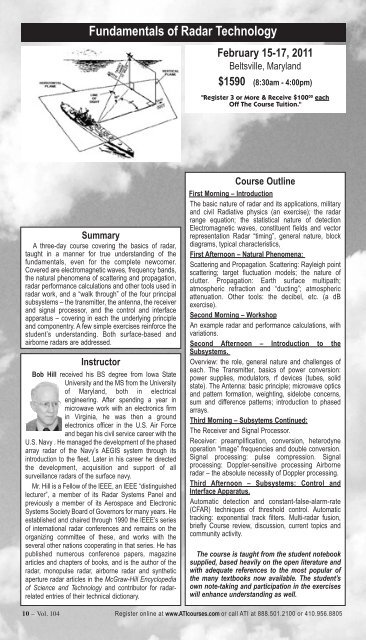Systems Engineering - ATI
Systems Engineering - ATI
Systems Engineering - ATI
Create successful ePaper yourself
Turn your PDF publications into a flip-book with our unique Google optimized e-Paper software.
Fundamentals of Radar Technology<br />
February 15-17, 2011<br />
Beltsville, Maryland<br />
$1590 (8:30am - 4:00pm)<br />
"Register 3 or More & Receive $100 00 each<br />
Off The Course Tuition."<br />
Summary<br />
A three-day course covering the basics of radar,<br />
taught in a manner for true understanding of the<br />
fundamentals, even for the complete newcomer.<br />
Covered are electromagnetic waves, frequency bands,<br />
the natural phenomena of scattering and propagation,<br />
radar performance calculations and other tools used in<br />
radar work, and a “walk through” of the four principal<br />
subsystems – the transmitter, the antenna, the receiver<br />
and signal processor, and the control and interface<br />
apparatus – covering in each the underlying principle<br />
and componentry. A few simple exercises reinforce the<br />
student’s understanding. Both surface-based and<br />
airborne radars are addressed.<br />
Instructor<br />
Bob Hill received his BS degree from Iowa State<br />
University and the MS from the University<br />
of Maryland, both in electrical<br />
engineering. After spending a year in<br />
microwave work with an electronics firm<br />
in Virginia, he was then a ground<br />
electronics officer in the U.S. Air Force<br />
and began his civil service career with the<br />
U.S. Navy . He managed the development of the phased<br />
array radar of the Navy’s AEGIS system through its<br />
introduction to the fleet. Later in his career he directed<br />
the development, acquisition and support of all<br />
surveillance radars of the surface navy.<br />
Mr. Hill is a Fellow of the IEEE, an IEEE “distinguished<br />
lecturer”, a member of its Radar <strong>Systems</strong> Panel and<br />
previously a member of its Aerospace and Electronic<br />
<strong>Systems</strong> Society Board of Governors for many years. He<br />
established and chaired through 1990 the IEEE’s series<br />
of international radar conferences and remains on the<br />
organizing committee of these, and works with the<br />
several other nations cooperating in that series. He has<br />
published numerous conference papers, magazine<br />
articles and chapters of books, and is the author of the<br />
radar, monopulse radar, airborne radar and synthetic<br />
aperture radar articles in the McGraw-Hill Encyclopedia<br />
of Science and Technology and contributor for radarrelated<br />
entries of their technical dictionary.<br />
Course Outline<br />
First Morning – Introduction<br />
The basic nature of radar and its applications, military<br />
and civil Radiative physics (an exercise); the radar<br />
range equation; the statistical nature of detection<br />
Electromagnetic waves, constituent fields and vector<br />
representation Radar “timing”, general nature, block<br />
diagrams, typical characteristics,<br />
First Afternoon – Natural Phenomena:<br />
Scattering and Propagation. Scattering: Rayleigh point<br />
scattering; target fluctuation models; the nature of<br />
clutter. Propagation: Earth surface multipath;<br />
atmospheric refraction and “ducting”; atmospheric<br />
attenuation. Other tools: the decibel, etc. (a dB<br />
exercise).<br />
Second Morning – Workshop<br />
An example radar and performance calculations, with<br />
variations.<br />
Second Afternoon – Introduction to the<br />
Subsystems.<br />
Overview: the role, general nature and challenges of<br />
each. The Transmitter, basics of power conversion:<br />
power supplies, modulators, rf devices (tubes, solid<br />
state). The Antenna: basic principle; microwave optics<br />
and pattern formation, weighting, sidelobe concerns,<br />
sum and difference patterns; introduction to phased<br />
arrays.<br />
Third Morning – Subsytems Continued:<br />
The Receiver and Signal Processor.<br />
Receiver: preamplification, conversion, heterodyne<br />
operation “image” frequencies and double conversion.<br />
Signal processing: pulse compression. Signal<br />
processing: Doppler-sensitive processing Airborne<br />
radar – the absolute necessity of Doppler processing.<br />
Third Afternoon – Subsystems: Control and<br />
Interface Apparatus.<br />
Automatic detection and constant-false-alarm-rate<br />
(CFAR) techniques of threshold control. Automatic<br />
tracking: exponential track filters. Multi-radar fusion,<br />
briefly Course review, discussion, current topics and<br />
community activity.<br />
The course is taught from the student notebook<br />
supplied, based heavily on the open literature and<br />
with adequate references to the most popular of<br />
the many textbooks now available. The student’s<br />
own note-taking and participation in the exercises<br />
will enhance understanding as well.<br />
10 – Vol. 104 Register online at www.<strong>ATI</strong>courses.com or call <strong>ATI</strong> at 888.501.2100 or 410.956.8805

















